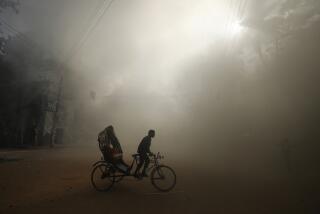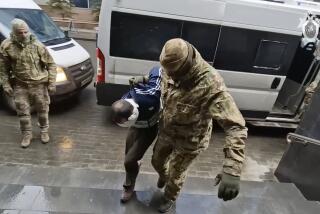Soviet Democracy Being Tested in Standoff in Central Asian Republic : Tadzhikistan: Protesters see a miniature Moscow coup. They are responding with a human blockade.
- Share via
DUSHANBE, Soviet Union — As thousands of students, professors, Muslim clergy and war veterans shook their fists and shouted “Resign! Resign! Resign!” outside the Tadzhikistan Parliament on Wednesday, a Soviet army tank commander stood just outside the crowd, listening intently as speaker after speaker mounted a makeshift stage.
Dressed in the uniform of a senior lieutenant, Tolajon Mir Usmanov, 26, an eight-year army veteran, was drawn by the sheer magnitude of events unfolding since Sunday at the base of a defiled Lenin statue here in the capital of the Soviet republic of Tadzhikistan.
The continuing standoff between the hard-line Communist regime in the Parliament building and the pro-democracy demonstrators, who have built a city of 64 tents a few dozen feet away, is providing the first major test of strength for Soviet democracy since the failed coup in Moscow last month.
What is going on in this Central Asian republic, protest leaders on the stage insisted Wednesday, is a Moscow coup in miniature. And the response is a mirror image of the human blockade that formed outside the Russian Parliament building a month ago.
“I support these people who gathered here,” Usmanov told a reporter. “Let them fight for their sovereignty and independence. Let them fight to speak their wishes frankly and openly. Let them achieve their goals of democracy.
“Let the people of America and the rest of the world know that the Soviet army will never interfere here. How can we fight against our own people? I promise you, the Soviet army will never again betray their own people or allow blood to flow in the streets of cities like Dushanbe.”
Just across the street, though, standing among the dozens of weary police militia who have been guarding the Parliament building for three days, a ranking colonel in the new regime’s interior police force offered a different view. “I do not consider this democracy,” said the burly colonel, who asked not to be identified by name. “These are just fundamentalist Islamic parties using democracy as their shield.”
Still, without the tanks and the muscle of the Soviet military, whose highest officials have indicated to leaders of both sides that it will not intercede, the colonel conceded that his police force had no immediate plans to clear the former Square of Lenin by force.
“We’ll just allow it to go on and on until they get tired and conk themselves out,” the colonel said. He explained that his force could allow the protests to continue, despite a state of emergency specifically banning such meetings, “because the demonstrations started before they announced the state of emergency.”
Such are the makings of what now appears to be a long standoff between the burgeoning forces of democracy in this once-progressive capital and a reactionary new regime that took power Monday in a series of moves that many liken to the hard-line August coup against Soviet President Mikhail S. Gorbachev more than 2,000 miles to the north.
To underscore the comparison, the protest leaders shouted their speeches and slogans from beneath two huge color portraits of Gorbachev and Russian Federation President Boris N. Yeltsin, whose opposition to the Moscow coup precipitated its collapse.
The photographs of the two leaders were taped to a large canvas tarpaulin covering the last remains of Dushanbe’s downtown Lenin statue--a monument that was at once the backdrop and the catalyst for the extraordinary events this week in Dushanbe.
It was last Saturday night when thousands of protesters gathered at the statue--in a plaza that had ironically been renamed Liberty Square two weeks earlier after Tadzhikistan had joined many other Soviet republics in declaring its independence.
Their message that night was clear: Ban the Communist Party.
To reinforce it, they enlisted the aid of at least two cranes to remove Lenin from his pedestal. But the cranes were too small, and despite nearly seven hours of trying, the crowd could only lift the 20-foot bronze Lenin from its roots and send it crashing to the ground, where it shattered into several pieces.
Within hours, several hundred committed Communist Party stalwarts gathered in the same square to stage their own protest meeting Sunday morning. They were chased away later in the day by a larger force of pro-democracy protesters.
Adding insult to injury, Tadzhikistan’s progressive president, Kadriddin Aslonov, who had been instrumental in steering the republic toward democratic reform after he took power Aug. 22, had scheduled a televised speech to the republic Sunday night in which he promised to issue the decree that would ban the Communist Party of Tadzhikistan.
Communist hard-liners, who still represented 90% of the republic’s Parliament, decided that enough was enough. They blocked Aslonov’s access to the republic’s TV station, and, in a Monday morning session, replaced Aslonov with hard-line Communist Party leader Rahmon Nabiyev, who had served as Tadzhikistan’s president during the Soviet presidency of Leonid I. Brezhnev.
The Parliament imposed a state of emergency, which bans all public meetings in Dushanbe and throughout the republic, authorizes police barricades and random vehicle searches in the capital and intensifies the police guard at all vital government installations.
“I appeal to all you brother citizens to remain calm and united,” Nabiyev told his republic in a televised address Tuesday night. “Don’t be too emotional. Be sober. Start solving the complex and vital problems facing the republic.”
Using the classic rhetoric of pre- perestroika Moscow, Nabiyev called the standoff in the capital “a very unstable time. . . . People cannot do their jobs. They can’t study. They can’t solve their problems. Is it wise to waste our precious time loitering on the streets and squares, complicating the life of the city? Once more, I appeal to your wisdom and sense of responsibility.”
Nabiyev declared that his takeover was entirely constitutional. Aslonov, he asserted, had “admitted his faults and asked for retirement,” and Parliament had elected Nabiyev to replace him.
Aslonov could not be located for comment Wednesday, nor could the city’s mayor, who was similarly ousted by the party Monday. But opposition leaders in Liberty Square on Wednesday left little doubt of their interpretation of the rapid relapse into Communist rule.
“It was a coup, just like in Moscow,” said Tokhir Abdul Jabbor, an economics professor and head of the People’s Movement of Tadzhikistan, one of three political parties sponsoring the night-and-day vigil in Liberty Square.
He delivered a bellowing speech below the decapitated Lenin monument as the hard-liners, who continued to conduct the affairs of state inside the Parliament building, occasionally peeked out of the windows. He later told a reporter that the demonstrators would outlast the Communist regime.
“It is the decision of all these people to stay here until the Communist Party vanishes from Tadzhikistan,” Jabbor said. Asked whether his group could last for days or weeks, he replied, “Months, even.”
The anti-Communist forces, dominated by long-bearded members of the republic’s fundamentalist Party of the Islamic Revival, are already dug in deep. They have erected 64 large, mushroom-shaped tents, some within 50 feet of the Parliament building, and set up a well-organized food and water supply system.
In one tent, bearing a poster that declares, “Political Hunger Strikers,” there is no need for food. The 20 protesters inside have vowed not to eat until democracy is restored, even if it means death.
“I wasn’t involved in politics at all until today,” said Akhtam Khushvakht, 37, a truck driver who was among the 20 hunger strikers. “But all of my troubles are due to the ideology of the Communist Party. I have wanted to take this stand for a long time, but it’s only now that I have ripened enough. The line has to be drawn somewhere.”
An Islamic fundamentalist member of the hunger striker team, Olim Dodarbek, added that he was taking his stand in the name of Allah. “Islam is the guardian of democracy,” he said.
In an adjacent tent, marked by a sign reading, “The headquarters of veterans of the Afghan war,” the mood was far more emotional and the implications far more dramatic. The scarred and limping protesters, who had been drafted to fight against their ethnic brothers in neighboring Afghanistan during the nine years of Soviet occupation there, said most of the 10,000-plus Afghan war veterans in Tadzhikistan blame the Communists for the war.
“When our troops occupied Afghanistan, we were deceived,” said Jurabek Usmani. “We were told we would fight the American Green Berets.”
Usmani’s eyes grew moist as he recalled the three years he spent as a paratrooper in the war before a mortar explosion disfigured the right side of his face and maimed his leg.
“It is the Central Committee of the Communist Party that sent us there, that lied to us,” Usmani said. “Maybe we understood it even then, but we could not afford to speak out. If you spoke against this war even in your dreams, it could mean the firing squad.
“It’s not that we are cowards. We are here, aren’t we? We are fighting again here, but another kind of war. And I will fight until we fire this Parliament.”
Usmani wiped his eyes and continued: “I hate these Communists not only for this war. Why do you hate the Mafia in America? And your Mafia is small. Here, they are very big. And we hope everyone in America, England, France and the other democracies of the world will hear us now. Please tell them in America that we need your backing now. But the Soviet army, the army these Communists sent into Afghanistan, they are with us now. They are with the people. That, I think, will make a difference.”
Usmani paused again and then added a personal message.
“Please,” he told a reporter, “send a great hello from us to our brothers in America, to all the Vietnam War veterans who are really no different than us.”
Tadzhikistan at a Glance
Capital: Dushanbe
Size: 55,240 square miles
Population: About 59% are Tadzhiks who speak an Iranian language and are Sunni Muslims. Another 23% are Uzbeks, and 10% are Russians and Ukrainians.
History: Formed from the Bokhara and Turkestan regions, it joined the Soviet Union in 1929. In August, 1990, its Supreme Soviet adopted a declaration of sovereignty.
Economy: Main occupations are farming, horticulture and cattle breeding. Eucalyptus and geraniums are grown for perfume industry.
More to Read
Sign up for Essential California
The most important California stories and recommendations in your inbox every morning.
You may occasionally receive promotional content from the Los Angeles Times.













